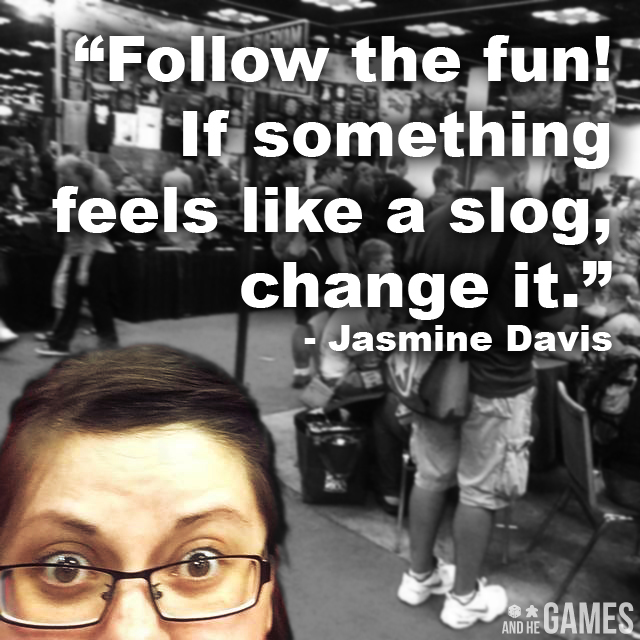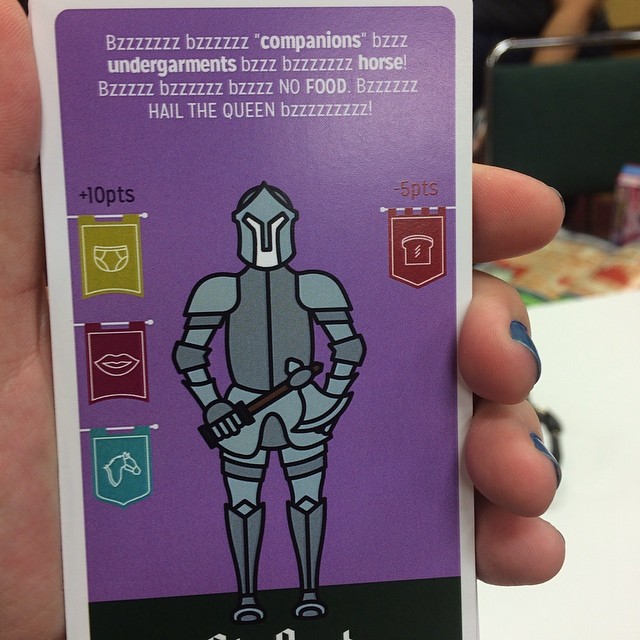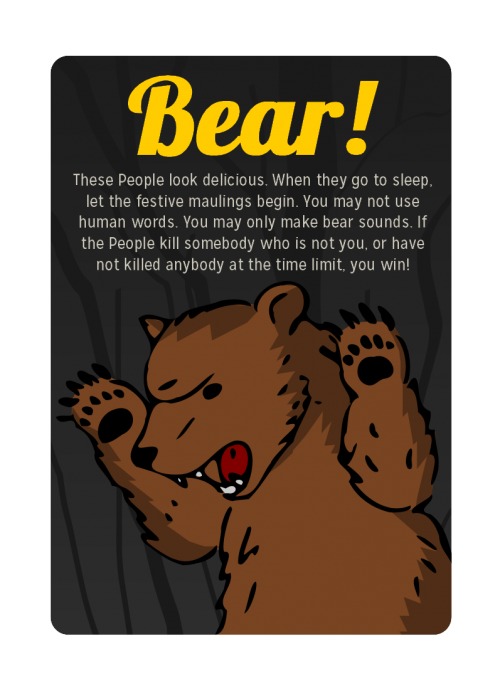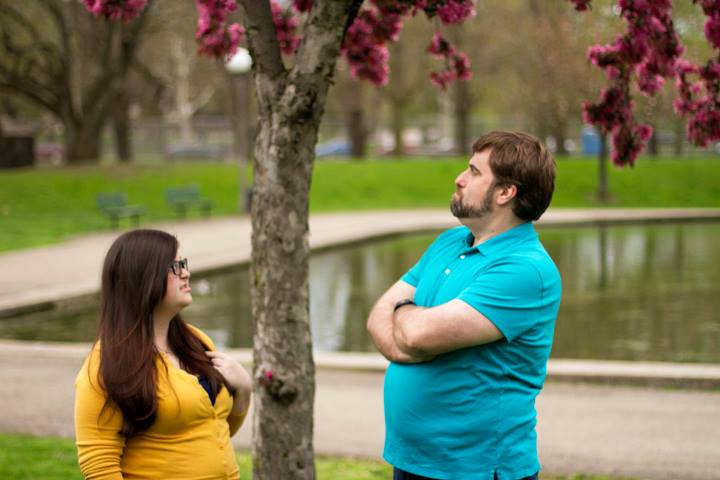
Tell us about yourself – Who are you? What do you do?
I work in content marketing at a small startup, so “what I do” isn’t super simple to answer (sometimes I’m editing! sometimes I write tweets! sometimes I call angry clients!). Outside of work, I’m a fiber artist and I design games.
This post has affiliate links, which directly support Andhegames.com at no extra cost to you. If you have any questions about anything recommended, let me know. – Andrew
If I’ve never played your games before, what’s the first one I should try?
That’s so tough to answer, because all my games are so differently, mechanically! But I’d recommend Knight Shift, since it has the broadest appeal. It’s a strategy card game, but can be played somewhat casually, too.
One fact that we probably don’t know about you:
I was one Art History class away from a minor in Cermics in college. I just really enjoyed spending time in the pottery studio (and the art building in general), so I took almost enough classes to be officially certified as a kind-of okay potter.
What tabletop games (including digital board/card games) are you playing most right now?
I play enough Ticket to Ride and Lost Cities via apps that it’s a little scary. In terms of physical tabletop games, lately I’ve been really into Tiny Epic Kingdoms, Steam Park, and The Builders: Middle Ages, a fun lightweight game I picked up in France. I’ve also been playing a lot of Hive with my husband. The last time we played it, maybe a year ago, he kept crushing me. But somehow in a year of not playing it, I became really good at it, so that’s fun.
What are your all-time favorite tabletop games?
I have a really soft spot for Carcassonne and Agricola. Carcassonne was the first “gamer game” I really got into. I bought the Big Box as a birthday gift for a guy who wound up dumping me, so I kept it. Agricola was the first game that my husband and I really played together.
What draws you to make games?
When I play games, I think, “Oh, I would love it if this game had X feature” or “Oh, what if you took this mechanic, but put this twist on it?” That’s a big part of what got me started was that desire to improve existing games or put new spins on mechanics. But what keeps me going these days is the ideas – when I realized that, as a game maker, I can make any kind of game I want, even if I’m the only one who thinks it’s a fun idea, I can. I have a game about clouds that collect stuff, a game about bears that fly airplanes, and a game about spirits who inhabit people while they sleep. These are super weird games that maybe wouldn’t be commercially successful (except for Bearplanes, let’s be honest), but are really fun to think about and make.
What are you not naturally good at, that you’ve learned to do for your work?
DESIGN. I’m pretty okay at Inkscape now, but when I started, I had no idea what I was doing. But now, I can make decent-looking prototypes. Nothing you’d write home about, but very functional. I actually want to get better at it, because I really enjoy it now.
Describe your process (or lack thereof) when making games. How do you reach your final product?
I work with my husband, Pete, on nearly all our games. We each have a couple of pet projects, but we’re pretty much always partners these days. It usually starts with a goofy idea that we talk through for a few days, weeks, or months. When we’ve come up with enough good ideas, we’ll start working to turn it into a prototype. So we might start out with something really silly, like the phrase, “One of you is a bear.” Then we’ll throw ideas back and forth and riff off one another. It might end there – as a fun conversation – or we might tweak it into a prototype. That’s how BEARanoia came to exist.
We’re both improvisors and have done a bit of performing around town, and we bring that kind of playfulness into our relationship and our game design. We’re both big fans of “yes, and” which helps us collaborate.
What game design-related media do you consume on a regular basis?
I’m part of the League of Gamemakers, so I’m on the Facebook group pretty much constantly. I also adore the Card & Board Game Designers Group on Facebook – it’s such a great resource for designers who are getting started. I also enjoy Twitter. I have a bunch of lists of designers that I follow. It’s a nice way to keep up with what’s current.
What are some tool/programs/supplies that you wouldn’t work without?
Inkscape A giant sketchbook Paper punches Index cards Sharpies
What’s your playtesting philosophy? How often/early do you playtest?
I’d rather get something out and to the table than anything else. So I’ve playtested some seriously ugly prototypes before, just to see if the concepts are solid. That said, I’ve learned that if I’m going to show something to anybody outside of my very immediate game designer group, I need something that’s kind of pretty. Otherwise, everyone gets hung up on what the art and design could be, rather than the gameplay.
Once we have the basic idea down, we often tweak on the fly with Sharpies and immediately test something new. If it works, we’ll put it in the next version. We also keep very extensive notes on our playtests, and when we get further along in the process, we have forms to collect feedback.
What are some of the biggest obstacles you’ve faced in your work, and how have you overcome them?
I went through a huge slump in late 2013 where I didn’t want to design games or even work on them. It took rethinking the purpose of designing games, for me, to get back into it. I realized, though, that it doesn’t fully matter to me whether a game is published or not. Some games can just be fun, or artistic, and that’s enough.
How do you handle life/family/work balance?
I don’t have kids. That probably helps. But I do have a demanding job and many other hobbies. I balance everything by trying to stick to a schedule. So, on Monday nights, we have “Domestic Night” where we do chores together. On Wednesdays, there’s a regular game night, so Tuesdays are often game making nights so we can have something ready to test. We’re not always great about it, but keeping a schedule helps us stay organized and make time for everything.
How many hours/week do you generally devote to game design? How many to other business-related activities?
I probably spend 8 to 20 hours a week on game design, but that includes things like emailing publishers, writing for the League of Gamemakers, and giving feedback in the Card & Board Game Designers Forum on Facebook.
What one piece of advice would you give aspiring game designers?
Get your first game onto paper as soon as you can and test it. It might not be “ready” but that’s kind of beside the point. Get it out, start testing it with close friends, and figure out what you can do to make it better. The longer you keep it spinning in your head, the easier it is to get really attached to concepts and mechanics that might not actually work like you think.
What’s the best advice about life that you’ve ever received?
Follow the fun! If something feels like a slog, change it. If there’s an option that gets more people talking, interacting, and laughing, then do that!
Who would you like to see answer these questions?
Have you had Teal Fristoe or Peter Vaughan do these yet?
(Nope, but I’ll add them to my list! – A)
_ _ _





